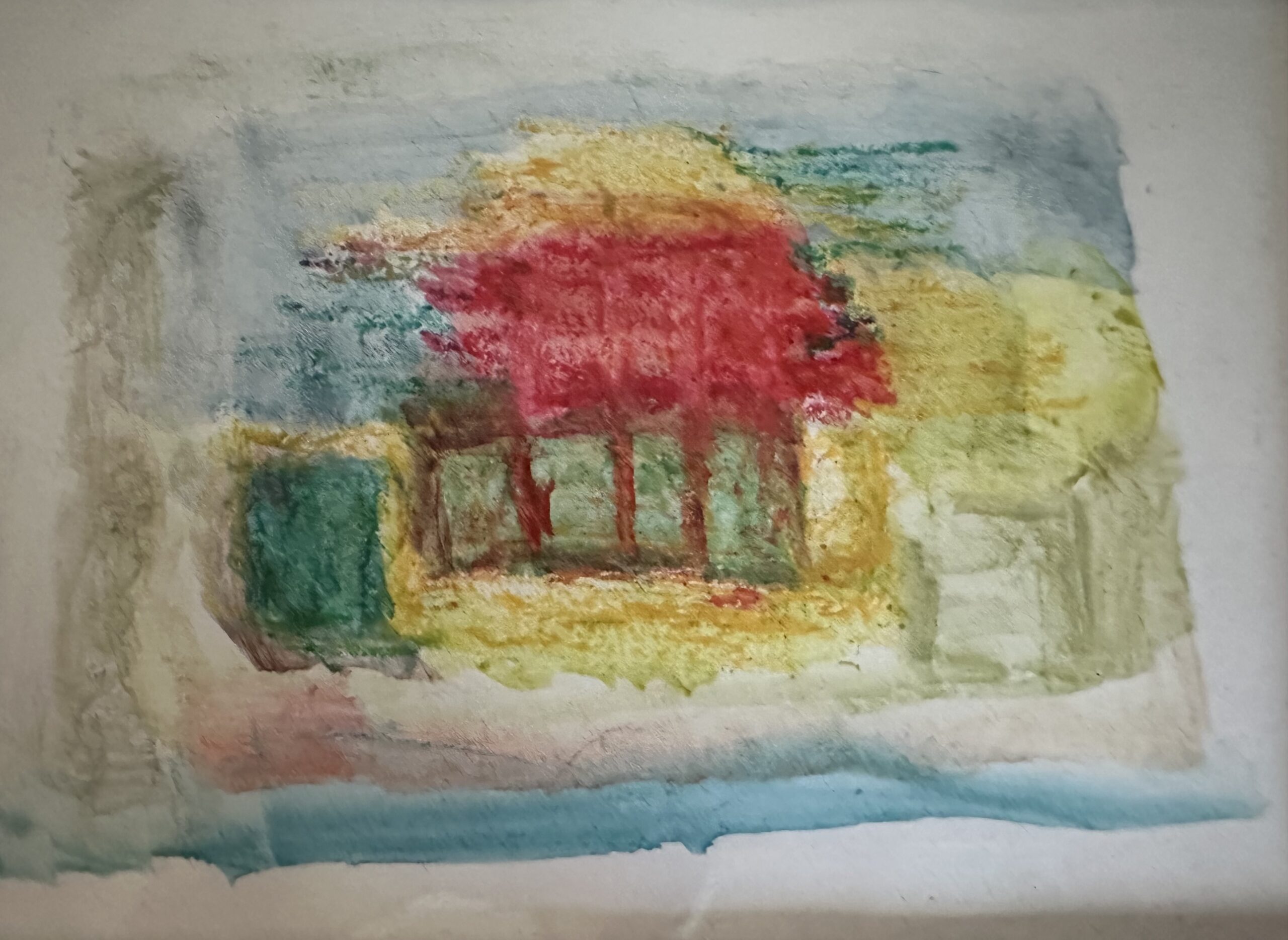
One month before the passing of Marc H. Ellis, I visited his place nestled in his beloved Cape Canaveral, Florida. I had already felt familiar with his neighborhood. Until he fell ill, Ellis had posted his photos taken at the beach, paintings, poems, and meditative words on Facebook. Only a few visits to his Facebook page might make people feel closer to Ellis and Cape Canaveral, even if they have never met him. Ellis is known as a Jewish liberation theologian, ethicist, and philosopher. Less known is that he was the photographer, painter, poet, and essayist who endeavored to embody prophetic Jewish identity aesthetically. The aesthetic side of Ellis’s life and work sheds new light on his political theology.
During our last conversation, I asked Ellis whether being Jewish was a lonely business. He answered, “Yes. Being my version of the Jewish is a lonely business…a Jew of conscience faithful to the prophetic. I’ve never given up being a Jew, a Jew in exile, a diasporic Jew, and an American Jew.” Jewish identity, probed through the complex relationship between the prophetic and the Jewish, was central to Ellis’s life and scholarship. In his prolific writings, Ellis engaged two ontological and ethical questions: What does the prophetic mean after a history of suffering and struggle for Jews and now after a history of suffering and struggle for Palestinians? What does it mean to be faithful as a Jew? His search for Jewish identity is a process of responding to concrete political issues and global crises. Thus, the process is as spiritual as material and as theological as political.
Ellis critically reflected on the irony of post-Holocaust Jewish identity. In 1948, the state of Israel was founded for the sake of carrying out Jewish identity, which the Holocaust had almost destroyed. The Holocaust memories of suffering justified the birth of Israel on Palestine. These memories have required the disciplining of Jewish identity through the political and military racializing apparatus of the modern nation-state, along with the myth of Jewish innocence and exceptionalism: Jews are innocent victims who do not oppress others, and, thus, Israel uses violence against Palestinians only for self-defense. As a result, according to Ellis, Jewish identity is placed on two polarized spectrums: Constantinian Jews and Jews of Conscience. The former perpetuate Jewish innocence and exceptionalism, aligning with empire and (neo)colonialism alive in Israel and the United States. Even progressive and liberal Jews can be Constantinian Jews due to their uncritical colonial sentiments and sense of moral superiority to Palestinians and third-world peoples.
On the contrary, as Ellis notes, Jews of Conscience are courageously “abandoning normative Jewish life without the prospect of return,” living and practicing exile (186). Jews of Conscience live in deep exile from their religious and political tradition, walking together with others of conscience in exile. The practice of exile portends solidarity for seeking justice among people of conscience. For Ellis, exile distinguishes Jews of Conscience from progressive and liberal Jews, although their political positions look similar on a surface level.
Jews of Conscience live in deep exile from their religious and political tradition, walking together with others of conscience in exile. The practice of exile portends solidarity for seeking justice among people of conscience.
Ellis warns of how the memories of suffering, such as those related to the Holocaust, serve oppressive political agendas. Thus, the particular Jewish experiences of exile and memories of the Holocaust should be transposed to other marginalized communities to illuminate the conditions, suffering, and miseries of genocide and globalized exile. This transposition can generate new memories for mutual understanding and solidarity for justice. As he notes in Future of the Prophetic, others’ memories of genocide and exile (i.e., Palestinians’ memories) should also be transposed to the Jewish community. Since dispersed people live with fragmented memories of their cultures and traditions, in the practice of exile, people of conscience share “what is left” with one another. Ellis underscores that what is left to Jews of Conscience is the indigenous Jewish prophetic, which is found among God’s chosen prophets in the Torah. Their messages were consistent in God’s justice for the poor and the marginalized in Israel, including foreigners. In a world where Israel’s oppression of Palestinians seems permanent, Jews of Conscience find their community in the New Diaspora, “a global gathering of diverse geographic, cultural, and political exiles” (215). Jews of Conscience find their voice and embody the Jewish prophetic in its evolving form.
In his last book, First Light, applies Edward Said’s concept of “late style” to the prophetic. In interpreting the radical changes in the final works of musicians and writers (i.e., Beethoven), Said argues that in art and in human life, late style transgresses linear progress. Late works appear catastrophic and anarchistic, as they combine “intransigence, difficulty, and unresolved contradiction” (195). Ellis probed the Late-Style Jewish Prophetic through Said’s lateness as “the idea of surviving beyond what is acceptable and normal” (195). In addition, one cannot go beyond, transcend, or lift oneself out of lateness but can only deepen it. At the end of ethical Jewish tradition, according to Ellis, the prophetic has entered its late style. The Late-Style Jewish Prophetic comes from an ancient tradition “while being performed anarchically in the present and is permanently exiled without a conscious desire to return” (196). In its lateness, the prophetic challenges Jews of Conscience, who already live in exile, to practice exile to its fullest. Contemplating the prophetic, Ellis refused the linear understanding of history and time. The Late-Style Jewish Prophetic is not the end of the prophetic. Instead, it disrupts and destroys the prophetic and simultaneously reemerges within the prophetic.
If Said’s memoir, Out of Place, is his late style, First Light exhibits Ellis’s. As his “love letter” to the prophetic, the book is filled with Ellis’s journals, poems, and paintings, suggesting how to embody the Late-Style Jewish Prophetic in the New Diaspora. The Late-Style Jewish Prophetic can only be embodied! For as long as he could, at dawn, Ellis walked more than a mile from his neighboring beach to what he named “The Chapel of Love” near Port Canaveral. At the chapel, Ellis welcomed the sunrise and meditated on Jewishness, Palestine, the beauty of life, his aching body, his two children, the prophetic, and more. His meditative words in First Light are combined with poems, beach photos, and paintings. Ellis was obsessed with painting. He painted everywhere with diverse materials—watercolor, oil, pencil, charcoal, and more. His favorite drawing spot was the back of the envelopes from random advertisers. Abstract images and prophetic messages frequently appear on Ellis’s canvases. Some of them look like palimpsestic pieces. His creative pieces deliver diverse moments of history and arouse memories of suffering, dystopia, lament, anarchy, and catastrophes. Simultaneously, they glow with hope, joy, healing, and beauty, as if the Late-Style Prophetic demanded alternative ways of revealing itself after its own “deconstruction and re-emergence” in the prophetic (xix). By walking, writing, painting, and taking photographs, Ellis took his whole person into the deepest solitude and found the fear there not to lose the prophetic voice. So, he could courageously practice exile and embody the prophetic in the face of the massive suffering, for instance, caused by a series of Israeli military campaigns on Gaza. The only way for Ellis to be Jewish was to become a Jew of Conscience who refuses the ideologies of empire but embodies the prophetic in the New Diaspora.
The New Diaspora reminds me of Gloria Anzaldúa’s nepantla, in-between space, where multiple worlds cross and collide, and, thus, alternative visions for justice grow while pain, uncertainties, self-transformation, decolonial thinking, and rebirth co-exist. Anzaldúa elaborates on nepantla as “a way of thinking, a mode of consciousness, and the ontological space where they occur” (161). Anzaldúa’s elaboration is applicable to the New Diaspora, and the aesthetic is an important language in nepantla. Ellis’s ontological and ethical struggle to be Jewish invites us to embody the prophetic aesthetically. Aesthetic embodiment requires our whole person—body, mind, spirit, and sensuality. People of conscience are connected in our deep yearning for wholeness and desire for liberation in the New Diaspora. Just as spiritual and material worlds intersect in nepantla, I now see the New Diaspora as a gathering of all people in exiles, including the living and the dead. We may find non-human living beings there, too. Hence, I can always see Ellis in the New Diaspora.


This is a beautiful tribute and introduction to work that will surely guide and inspire me in my own late stage. Thank you.
I have been debating with jewish zionists in south Africa that there must be a jewish liberation theology, but not having a single name to support my position. A few weeks ago I discovered Marc Ellis’ book in my library, and was delighted that he is (probably?) the most eminent of them. Your article Keunjoo, introduced me to ‘an aesthetic jew of conscience’ linked to the fascinating concept of ‘napuntla’ as having access to two worlds but being between them as well with the pain of uncertainty, and having the courage to find one’s way without the certainty of a goal. This is an apt description of the current world, one where we have to live with inbetweeness but with optimism. Coming from a christian background, and growing out of it – partly – into christian liberation theology, I have found Spinoza, and Vygotsky as the only jewish philosophers who could inspire a jewish liberation theology through the secularisation of their ideas. I am hoping to find other names, so I can read about their ideas. Thank you for your thoughtful article.